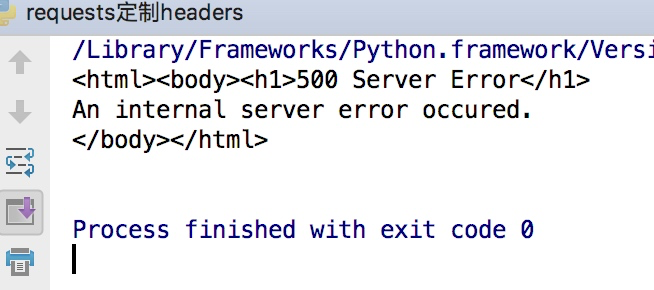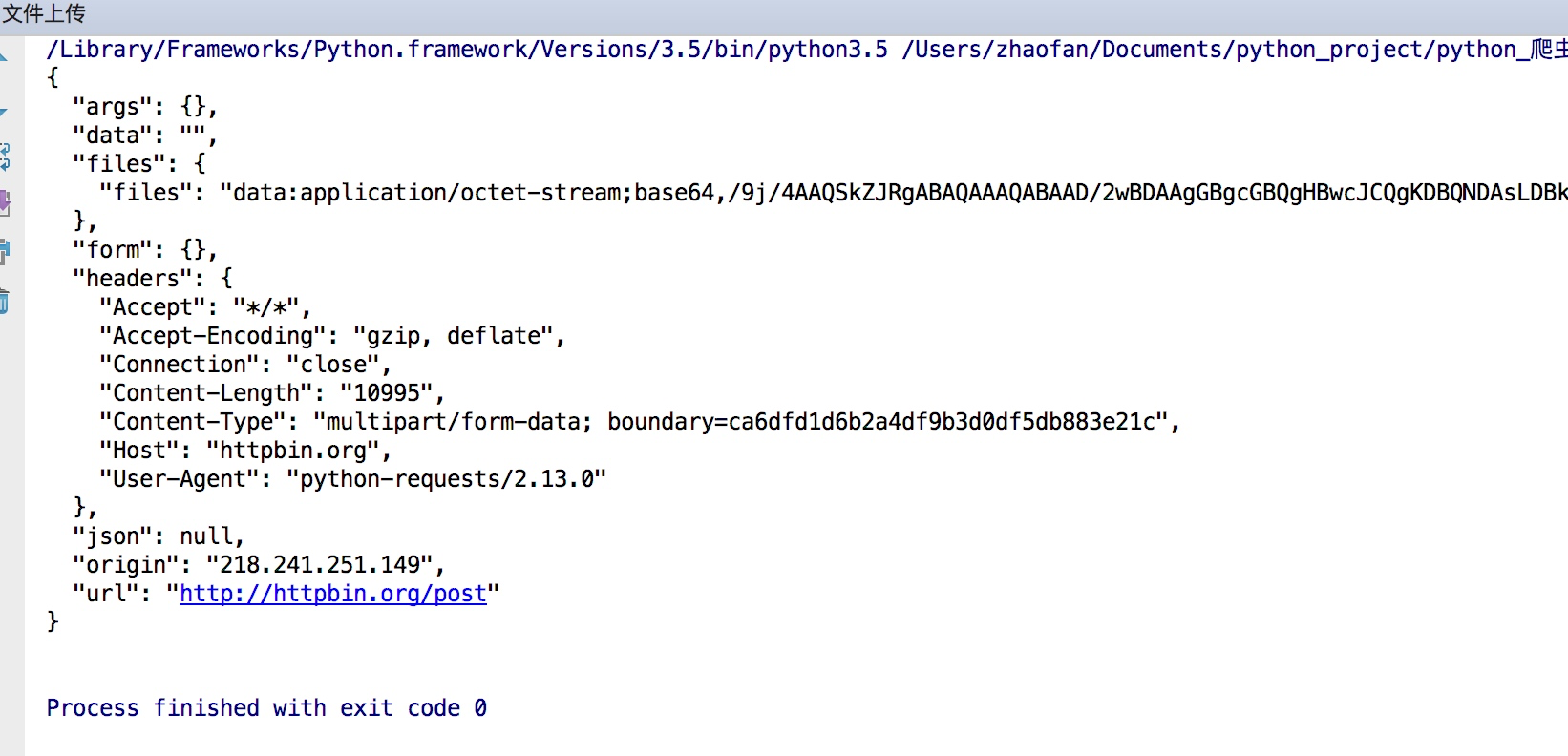python爬虫从入门到放弃(四)之 Requests库的基本使用(转)
什么是Requests
Requests是用python语言基于urllib编写的,采用的是Apache2 Licensed开源协议的HTTP库
如果你看过上篇文章关于urllib库的使用,你会发现,其实urllib还是非常不方便的,而Requests它会比urllib更加方便,可以节约我们大量的工作。(用了requests之后,你基本都不愿意用urllib了)一句话,requests是python实现的最简单易用的HTTP库,建议爬虫使用requests库。
默认安装好python之后,是没有安装requests模块的,需要单独通过pip安装
requests功能详解
总体功能的一个演示
import requests
response = requests.get("https://www.baidu.com")
print(type(response))
print(response.status_code)
print(type(response.text))
print(response.text)
print(response.cookies)
print(response.content)
print(response.content.decode("utf-8"))
我们可以看出response使用起来确实非常方便,这里有个问题需要注意一下:
很多情况下的网站如果直接response.text会出现乱码的问题,所以这个使用response.content
这样返回的数据格式其实是二进制格式,然后通过decode()转换为utf-8,这样就解决了通过response.text直接返回显示乱码的问题.
请求发出后,Requests 会基于 HTTP 头部对响应的编码作出有根据的推测。当你访问 response.text 之时,Requests 会使用其推测的文本编码。你可以找出 Requests 使用了什么编码,并且能够使用 response.encoding 属性来改变它.如:
response =requests.get("http://www.baidu.com")
response.encoding="utf-8"
print(response.text)
不管是通过response.content.decode("utf-8)的方式还是通过response.encoding="utf-8"的方式都可以避免乱码的问题发生
各种请求方式
requests里提供个各种请求方式
import requests
requests.post("http://httpbin.org/post")
requests.put("http://httpbin.org/put")
requests.delete("http://httpbin.org/delete")
requests.head("http://httpbin.org/get")
requests.options("http://httpbin.org/get")
请求
基本GET请求
import requests
response = requests.get('http://httpbin.org/get')
print(response.text)
带参数的GET请求,例子1
import requests
response = requests.get("http://httpbin.org/get?name=zhaofan&age=23")
print(response.text)
如果我们想要在URL查询字符串传递数据,通常我们会通过httpbin.org/get?key=val方式传递。Requests模块允许使用params关键字传递参数,以一个字典来传递这些参数,例子如下:
import requests
data = {
"name":"zhaofan",
"age":22
}
response = requests.get("http://httpbin.org/get",params=data)
print(response.url)
print(response.text)
上述两种的结果是相同的,通过params参数传递一个字典内容,从而直接构造url
注意:第二种方式通过字典的方式的时候,如果字典中的参数为None则不会添加到url上
解析json
import requests
import json response = requests.get("http://httpbin.org/get")
print(type(response.text))
print(response.json())
print(json.loads(response.text))
print(type(response.json()))
从结果可以看出requests里面集成的json其实就是执行了json.loads()方法,两者的结果是一样的
获取二进制数据
在上面提到了response.content,这样获取的数据是二进制数据,同样的这个方法也可以用于下载图片以及
视频资源
添加headers
和前面我们将urllib模块的时候一样,我们同样可以定制headers的信息,如当我们直接通过requests请求知乎网站的时候,默认是无法访问的
import requests
response =requests.get("https://www.zhihu.com")
print(response.text)
这样会得到如下的错误

因为访问知乎需要头部信息,这个时候我们在谷歌浏览器里输入chrome://version,就可以看到用户代理,将用户代理添加到头部信息

import requests
headers = { "User-Agent":"Mozilla/5.0 (Macintosh; Intel Mac OS X 10_12_4) AppleWebKit/537.36 (KHTML, like Gecko) Chrome/58.0.3029.110 Safari/537.36"
}
response =requests.get("https://www.zhihu.com",headers=headers) print(response.text)
这样就可以正常的访问知乎了
基本POST请求
通过在发送post请求时添加一个data参数,这个data参数可以通过字典构造成,这样
对于发送post请求就非常方便
import requests
data = {
"name":"zhaofan",
"age":23
}
response = requests.post("http://httpbin.org/post",data=data)
print(response.text)
同样的在发送post请求的时候也可以和发送get请求一样通过headers参数传递一个字典类型的数据
响应
我们可以通过response获得很多属性,例子如下
import requests
response = requests.get("http://www.baidu.com")
print(type(response.status_code),response.status_code)
print(type(response.headers),response.headers)
print(type(response.cookies),response.cookies)
print(type(response.url),response.url)
print(type(response.history),response.history)
结果如下:

状态码判断
Requests还附带了一个内置的状态码查询对象
主要有如下内容:
100: ('continue',),
101: ('switching_protocols',),
102: ('processing',),
103: ('checkpoint',),
122: ('uri_too_long', 'request_uri_too_long'),
200: ('ok', 'okay', 'all_ok', 'all_okay', 'all_good', '\o/', '✓'),
201: ('created',),
202: ('accepted',),
203: ('non_authoritative_info', 'non_authoritative_information'),
204: ('no_content',),
205: ('reset_content', 'reset'),
206: ('partial_content', 'partial'),
207: ('multi_status', 'multiple_status', 'multi_stati', 'multiple_stati'),
208: ('already_reported',),
226: ('im_used',),
Redirection.
300: ('multiple_choices',),
301: ('moved_permanently', 'moved', '\o-'),
302: ('found',),
303: ('see_other', 'other'),
304: ('not_modified',),
305: ('use_proxy',),
306: ('switch_proxy',),
307: ('temporary_redirect', 'temporary_moved', 'temporary'),
308: ('permanent_redirect',
'resume_incomplete', 'resume',), # These 2 to be removed in 3.0
Client Error.
400: ('bad_request', 'bad'),
401: ('unauthorized',),
402: ('payment_required', 'payment'),
403: ('forbidden',),
404: ('not_found', '-o-'),
405: ('method_not_allowed', 'not_allowed'),
406: ('not_acceptable',),
407: ('proxy_authentication_required', 'proxy_auth', 'proxy_authentication'),
408: ('request_timeout', 'timeout'),
409: ('conflict',),
410: ('gone',),
411: ('length_required',),
412: ('precondition_failed', 'precondition'),
413: ('request_entity_too_large',),
414: ('request_uri_too_large',),
415: ('unsupported_media_type', 'unsupported_media', 'media_type'),
416: ('requested_range_not_satisfiable', 'requested_range', 'range_not_satisfiable'),
417: ('expectation_failed',),
418: ('im_a_teapot', 'teapot', 'i_am_a_teapot'),
421: ('misdirected_request',),
422: ('unprocessable_entity', 'unprocessable'),
423: ('locked',),
424: ('failed_dependency', 'dependency'),
425: ('unordered_collection', 'unordered'),
426: ('upgrade_required', 'upgrade'),
428: ('precondition_required', 'precondition'),
429: ('too_many_requests', 'too_many'),
431: ('header_fields_too_large', 'fields_too_large'),
444: ('no_response', 'none'),
449: ('retry_with', 'retry'),
450: ('blocked_by_windows_parental_controls', 'parental_controls'),
451: ('unavailable_for_legal_reasons', 'legal_reasons'),
499: ('client_closed_request',),
Server Error.
500: ('internal_server_error', 'server_error', '/o\', '✗'),
501: ('not_implemented',),
502: ('bad_gateway',),
503: ('service_unavailable', 'unavailable'),
504: ('gateway_timeout',),
505: ('http_version_not_supported', 'http_version'),
506: ('variant_also_negotiates',),
507: ('insufficient_storage',),
509: ('bandwidth_limit_exceeded', 'bandwidth'),
510: ('not_extended',),
511: ('network_authentication_required', 'network_auth', 'network_authentication'),
通过下面例子测试:(不过通常还是通过状态码判断更方便)
import requests
response= requests.get("http://www.baidu.com")
if response.status_code == requests.codes.ok:
print("访问成功")
requests高级用法
文件上传
实现方法和其他参数类似,也是构造一个字典然后通过files参数传递
import requests
files= {"files":open("git.jpeg","rb")}
response = requests.post("http://httpbin.org/post",files=files)
print(response.text)
结果如下:

获取cookie
import requests
response = requests.get("http://www.baidu.com")
print(response.cookies)
for key,value in response.cookies.items():
print(key+"="+value)
会话维持
cookie的一个作用就是可以用于模拟登陆,做会话维持
import requests
s = requests.Session()
s.get("http://httpbin.org/cookies/set/number/123456")
response = s.get("http://httpbin.org/cookies")
print(response.text)
这是正确的写法,而下面的写法则是错误的
import requests
requests.get("http://httpbin.org/cookies/set/number/123456")
response = requests.get("http://httpbin.org/cookies")
print(response.text)
因为这种方式是两次requests请求之间是独立的,而第一次则是通过创建一个session对象,两次请求都通过这个对象访问
证书验证
现在的很多网站都是https的方式访问,所以这个时候就涉及到证书的问题
import requests
response = requests.get("https:/www.12306.cn")
print(response.status_code)
默认的12306网站的证书是不合法的,这样就会提示如下错误

为了避免这种情况的发生可以通过verify=False
但是这样是可以访问到页面,但是会提示:
InsecureRequestWarning: Unverified HTTPS request is being made. Adding certificate verification is strongly advised. See: https://urllib3.readthedocs.io/en/latest/advanced-usage.html#ssl-warnings InsecureRequestWarning)
解决方法为:
import requests
from requests.packages import urllib3
urllib3.disable_warnings()
response = requests.get("https://www.12306.cn",verify=False)
print(response.status_code)
这样就不会提示警告信息,当然也可以通过cert参数放入证书路径
代理设置
import requests
proxies= {
"http":"http://127.0.0.1:9999",
"https":"http://127.0.0.1:8888"
}
response = requests.get("https://www.baidu.com",proxies=proxies)
print(response.text)
如果代理需要设置账户名和密码,只需要将字典更改为如下:
proxies = {
"http":"http://user:password@127.0.0.1:9999"
}
如果你的代理是通过sokces这种方式则需要pip install "requests[socks]"
proxies= {
"http":"socks5://127.0.0.1:9999",
"https":"sockes5://127.0.0.1:8888"
}
超时设置
通过timeout参数可以设置超时的时间
认证设置
如果碰到需要认证的网站可以通过requests.auth模块实现
import requests
from requests.auth import HTTPBasicAuth
response = requests.get("http://120.27.34.24:9001/",auth=HTTPBasicAuth("user","123"))
print(response.status_code)
当然这里还有一种方式
import requests
response = requests.get("http://120.27.34.24:9001/",auth=("user","123"))
print(response.status_code)
异常处理
关于reqeusts的异常在这里可以看到详细内容:
http://www.python-requests.org/en/master/api/#exceptions
所有的异常都是在requests.excepitons中

从源码我们可以看出RequestException继承IOError,
HTTPError,ConnectionError,Timeout继承RequestionException
ProxyError,SSLError继承ConnectionError
ReadTimeout继承Timeout异常
这里列举了一些常用的异常继承关系,详细的可以看:
http://cn.python-requests.org/zh_CN/latest/_modules/requests/exceptions.html#RequestException
通过下面的例子进行简单的演示
import requests from requests.exceptions import ReadTimeout,ConnectionError,RequestException try:
response = requests.get("http://httpbin.org/get",timout=0.1)
print(response.status_code)
except ReadTimeout:
print("timeout")
except ConnectionError:
print("connection Error")
except RequestException:
print("error")
其实最后测试可以发现,首先被捕捉的异常是timeout,当把网络断掉的haul就会捕捉到ConnectionError,如果前面异常都没有捕捉到,最后也可以通过RequestExctption捕捉到
原文地址 http://www.cnblogs.com/zhaof/p/6915127.html
python爬虫从入门到放弃(四)之 Requests库的基本使用(转)的更多相关文章
- python爬虫从入门到放弃(四)之 Requests库的基本使用
什么是Requests Requests是用python语言基于urllib编写的,采用的是Apache2 Licensed开源协议的HTTP库如果你看过上篇文章关于urllib库的使用,你会发现,其 ...
- python爬虫从入门到放弃前奏之学习方法
首谈方法 最近在整理爬虫系列的博客,但是当整理几篇之后,发现一个问题,不管学习任何内容,其实方法是最重要的,按照我之前写的博客内容,其实学起来还是很点枯燥不能解决传统学习过程中的几个问题: 这个是普通 ...
- python爬虫从入门到放弃(二)之爬虫的原理
在上文中我们说了:爬虫就是请求网站并提取数据的自动化程序.其中请求,提取,自动化是爬虫的关键!下面我们分析爬虫的基本流程 爬虫的基本流程 发起请求通过HTTP库向目标站点发起请求,也就是发送一个Req ...
- Python爬虫笔记一(来自MOOC) Requests库入门
Python爬虫笔记一(来自MOOC) 提示:本文是我在中国大学MOOC里面自学以及敲的一部分代码,纯一个记录文,如果刚好有人也是看的这个课,方便搬运在自己电脑上运行. 课程为:北京理工大学-嵩天-P ...
- Python爬虫从入门到放弃(二十四)之 Scrapy登录知乎
因为现在很多网站为了限制爬虫,设置了为只有登录才能看更多的内容,不登录只能看到部分内容,这也是一种反爬虫的手段,所以这个文章通过模拟登录知乎来作为例子,演示如何通过scrapy登录知乎 在通过scra ...
- Python爬虫从入门到放弃(十四)之 Scrapy框架中选择器的用法
Scrapy提取数据有自己的一套机制,被称作选择器(selectors),通过特定的Xpath或者CSS表达式来选择HTML文件的某个部分Xpath是专门在XML文件中选择节点的语言,也可以用在HTM ...
- python爬虫从入门到放弃(三)之 Urllib库的基本使用
官方文档地址:https://docs.python.org/3/library/urllib.html 什么是Urllib Urllib是python内置的HTTP请求库包括以下模块urllib.r ...
- python爬虫从入门到放弃(六)之 BeautifulSoup库的使用
上一篇文章的正则,其实对很多人来说用起来是不方便的,加上需要记很多规则,所以用起来不是特别熟练,而这节我们提到的beautifulsoup就是一个非常强大的工具,爬虫利器. beautifulSoup ...
- python爬虫从入门到放弃(八)之 Selenium库的使用
一.什么是Selenium selenium 是一套完整的web应用程序测试系统,包含了测试的录制(selenium IDE),编写及运行(Selenium Remote Control)和测试的并行 ...
随机推荐
- docker 环境下创建 overlay 网络方案
一.环境 三台机器,其中一台安装 consul(192.168.1.21), 两台创建网络(192.168.1.32,33) 二.实现步骤 1.构建环境 1)三台机器部署docker环境 2)选择一台 ...
- 转载:git和github新手安装使用教程(三步入门)
转载防止以后电脑重装,找不到记录. 教程地址:https://www.cnblogs.com/ttjsndx/p/7943444.html
- FIFO队列 ADT接口 链表实现
FIFO.h (接口) #include "Item.h" void QUEUinit(int); int QUEUempty(void); void QUEUput(Item); ...
- 成都Uber优步司机奖励政策(2月7日)
滴快车单单2.5倍,注册地址:http://www.udache.com/ 如何注册Uber司机(全国版最新最详细注册流程)/月入2万/不用抢单:http://www.cnblogs.com/mfry ...
- 卸载Oracle 11g
卸载oracle只需要执行deinstall.ba即可 运行.bat文件 按照提示步骤进行卸载 .bat文件所在目录需要手动删除,需要在程序管理器里面关掉Oracle的进程,在删除当前文件夹
- hugepages_settings.sh
#!/bin/bash## hugepages_settings.sh## Linux bash script to compute values for the# recommended HugeP ...
- 【springboot-01】整合quartz
1.什么是quartz? quartz是一个开源的定时任务框架,具备将定时任务持久化至数据库以及分布式环境下多节点调度的能力.当当的elastic-job便是以quartz为基础,结合zookeepe ...
- 2019年猪年海报PSD模板-第四部分
14套精美猪年海报,免费猪年海报,下载地址:百度网盘,https://pan.baidu.com/s/1WUO4L5PHIHG5hAurv52_2A
- git配置github链接
1.百度git官网-下载最新版git 2.一路默认下一步安装 3.打开 git bash here 命令行 4.注册github账号(用自己的邮箱就可以,不会英文可以用谷歌翻译)注册成功后建立项目 5 ...
- Java开发工程师(Web方向) - 01.Java Web开发入门 - 第1章.Web应用开发概述
第1章--Web应用开发概述 Web应用开发概述 浏览器-服务器架构(BS-architecture) browser/ App ---- request ----> server ...
